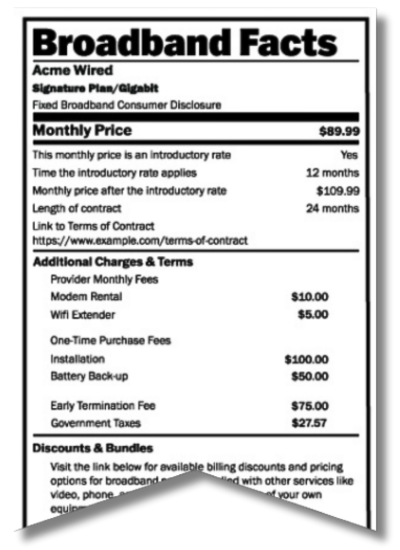-
The FCC is requiring most ISPs to publish consumer labels for fixed and wireless plans by April 10
-
Ookla VP Bryan Darr told Fierce ISPs face “a number” of regulatory risks with the broadband label requirements
-
Lack of transparency on broadband pricing is one of the obstacles in closing the digital divide
Soon, getting info on a broadband provider will be as easy as checking the label on the back of a cereal box. Or so we hope!
The FCC is requiring the majority of ISPs to display broadband consumer labels at the point of sale by April 10. Those labels must disclose information (in an easy-to-read manner) about a provider’s monthly pricing, upload and download speeds, data allowances as well as links to the ISP’s network management practices and privacy policies.
The April 10 deadline applies to ISPs that have more than 100,000 subscriber lines, while smaller providers have until October 10 to publish the labels on their points of sale. Those points of sale include both an ISP’s website and its physical storefront.

Bryan Darr, VP of government affairs at Ookla, told Fierce Network he thinks there are “a number” of regulatory risks for the ISPs. First, the “administrative headache” it’s going to be to implement these labels, regardless of an operator’s size.
“It tends to always be more impactful for smaller operators that don’t have an army of administrative people working for them. Then again, many of these are small, single-market operators or at least have clustered systems and they may not have as many markets that they have to worry about,” he said. “But these broadband labels have to be updated regularly.”
Meaning if ISPs have “any kind of a price change,” they’ll have to change their labels to reflect that. So, not only will they have to update that info online, “they’ve actually got to print something out and display [it].”
For Ookla’s part, it plans to provide ISPs with the opportunity to use its data as a third-party validation service, Darr said. This would allow providers to validate “the claims that they make” on download and upload speeds as well as latency.
Another “complication” about label compliance, he went on to say, is the FCC has stipulated ISPs have to publish their “typical” download/upload speeds, latency numbers, “without defining what typical is.”
“And I think that’s one of the significant risks that exists here for these operators,” said Darr. “Because what people experience on their devices can often be quite different than what’s being delivered to the service address.”
That’s one of the things ISPs “have no control over” with the labels. While ISPs can state how much they charge for each of their speed tiers, they can’t show “what people perceive as their delivered speeds.”
More options for consumers
As for how the broadband labels will impact consumers, Darr explained they’ll most likely benefit people who are unsatisfied with their internet service, whether that’s due to reliability, or consistency or cost, and want to shop around for a different ISP.
For those that are happy with their service, “I doubt they’ll pay attention [to the labels] at all until something makes them unhappy.”
Operators are already getting ready to implement the FCC’s requirements, if they haven’t already. Google Fiber launched its broadband consumer labels in October, and companies like T-Mobile and Verizon already have landing pages where you can access labels for both consumer and business internet plans.
“I don't think what the FCC is asking for will be difficult for the companies,” said New Street Research analyst Blair Levin. “And I think the companies already have a significant amount of information about what their competitors are offering.”
How the labels will impact competition among providers is a different matter, as he noted “there are switching costs that keep churn reasonably low in the market.”
“But labels do provide a way for consumers to have a better understanding of their options if and when they decide they would like an alternative,” said Levin.
Indeed, a “lack of transparent, precise data” on consumer broadband pricing is one of the biggest challenges in providing affordable internet access, said Colby Humphrey, a broadband policy researcher at the Pew Charitable Trusts.
“Government officials, researchers, and consumers all need this information. Researchers need it to guide the evaluation of broadband programs. State officials need it to successfully meet federal affordability targets and collaborate productively with internet service providers,” Humphrey said. “And consumers need this information to make informed decisions about what plan to purchase from which provider. Without clear, detailed data on pricing, efforts to get all Americans online will continue to fall short.”